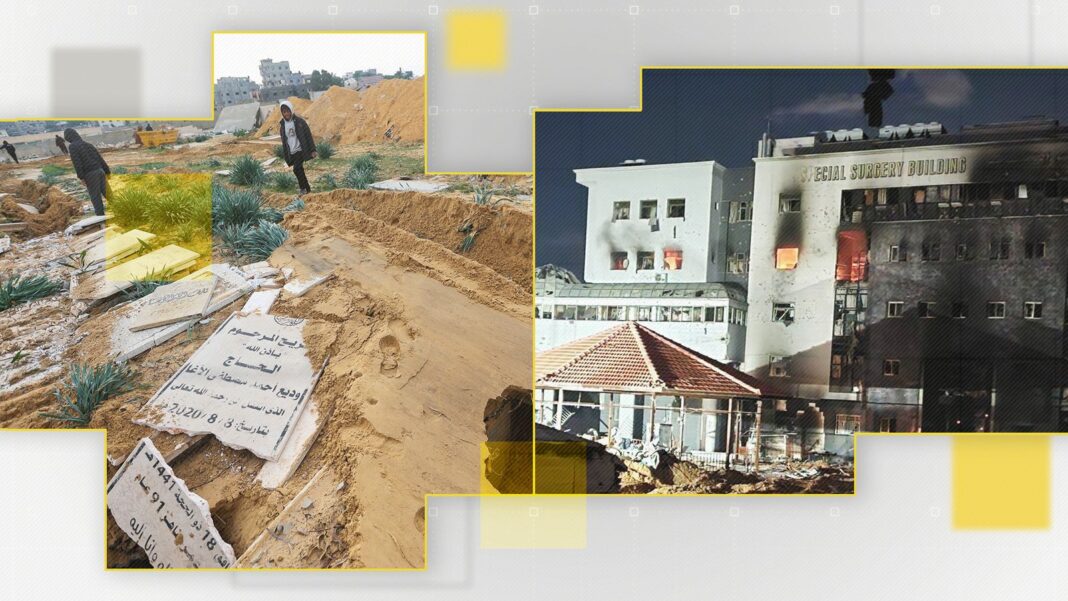During the first months of the war in Gaza, deaths were counted through a network of computers connecting morgues across the territory.
It was a system that, in the years beforehand, had won the trust of human rights groups, the UN and the World Health Organisation.
But amid repeated Israeli attacks on hospitals and chronic fuel shortages, this system has now effectively collapsed.
Of the eight major hospitals responsible for collating morgue data, just three are still providing information to the health ministry.
As a result, the morgue monitoring system is now only capturing a small fraction of deaths across the territory.
This content is provided by Datawrapper, which may be using cookies and other technologies.
To show you this content, we need your permission to use cookies.
You can use the buttons below to amend your preferences to enable Datawrapper cookies or to allow those cookies just once.
You can change your settings at any time via the Privacy Options.
Unfortunately we have been unable to verify if you have consented to Datawrapper cookies.
To view this content you can use the button below to allow Datawrapper cookies for this session only.
The Gaza Strip’s Hamas-run health ministry says 32,916 Palestinians have been killed since the war began.
On Wednesday, they released the name, age and ID number of every identified fatality. The list runs to some 454 pages, but it is far from complete.
Missing are the names of 11,593 people who the ministry says have been killed, but whose identities it has been unable to confirm.
As Gaza’s health system has collapsed, the share of unidentified deaths has grown – making up 81% of additions to the total number of fatalities in March, up from 69% in January.
‘Exceptional and difficult circumstances’
Speaking to the media for the first time, the man in charge of Gaza’s mortality statistics told Sky News that his team are operating in “exceptional and difficult circumstances”.
“Northern Gaza has been out of contact since 10 November,” says Zaher al Wahaidi, who has led the health ministry’s Health Information Centre for the past year.
“That’s when the main health data centre at al Shifa hospital was attacked and all the servers were taken. The alternative data centre at al Rantisi hospital was also assaulted on this date.”
The data systems at al Shifa had been reactivated in early March, he says, before Israel launched its second assault on the hospital. “With the continuous attacks, all arrangements collapsed.”
Images from the raid’s aftermath show the hospital lying in ruins.
Israel says it killed 200 Hamas fighters during the attack, and that no civilians were harmed. Officials in Gaza put the number killed at more than 400, including “hundreds of civilians”.
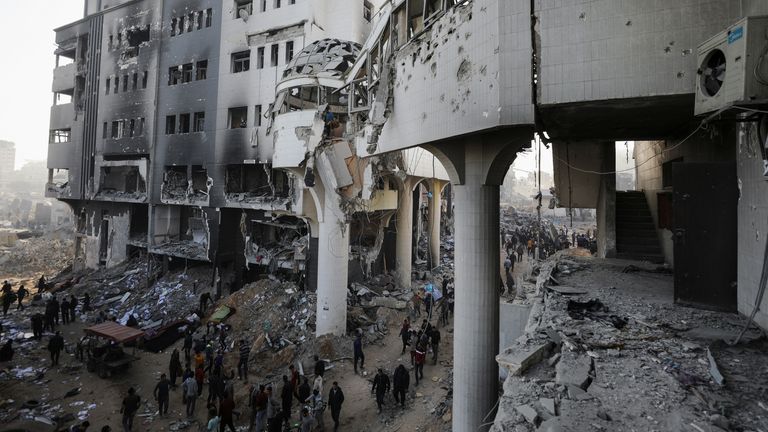
Palestinians inspect damage at al Shifa hospital. Pic: Reuters
How many of the dead are civilians?
Of the 32,916 Palestinians reportedly killed in the war so far, it’s not clear how many are civilians.
In February, a Hamas source told Reuters that 6,000 of the group’s fighters had been killed. The Israeli military put the figure at closer to 12,000.
The data from Gaza’s health ministry does not distinguish between civilians and combatants. Instead, outside observers have been left relying on the number of women, children and elderly people killed as an indication of the scale of civilian harm.
Of the 21,703 identified fatalities whose details have been shared by the Hamas-run health ministry, 13,207 were women, children or elderly (61%).
Until recently, however, the ministry had been reporting a figure of 72%.
Mr al Wahaidi told Sky News that this was a “media estimate”. He was not able to explain the basis for this estimate or who had produced it.
Since speaking to Sky News, he has stopped using this figure in his reports for the health ministry. It continues to be used by the government media office, a separate branch of Gaza’s government.
Please use Chrome browser for a more accessible video player
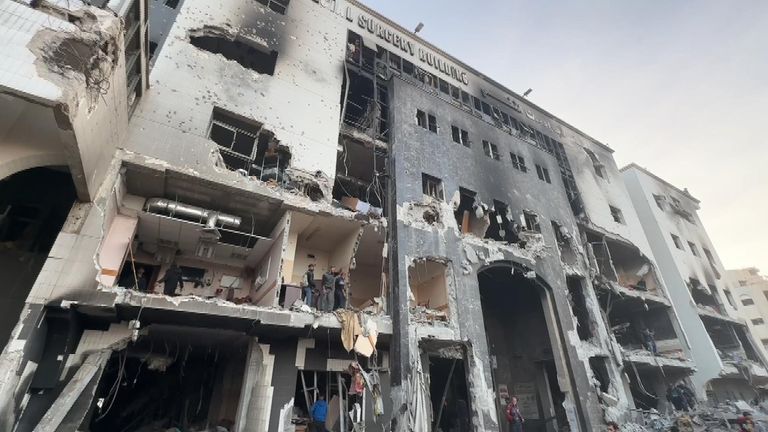
1:24
Gaza hospital buildings ‘targeted’
‘It’s probably an undercount, if anything’
The health ministry says Israeli attacks have brought the health system to “almost complete paralysis” – forcing the closure of 32 hospitals.
Mr al Wahaidi says that, without access to digital systems, hospitals in the north of Gaza have been unable to match the dead with the government’s population registry, leaving thousands of bodies unidentified.
“Almost 4,000 martyrs were manually registered in Kamal Adwan hospital whose data is incomplete, and 2,000 at al Shifa hospital,” he says.
Other bodies are buried without passing through a hospital – or remain trapped under the rubble.
Mr al Wahaidi says that his team rely on reports from journalists and first responders to collate reports of deaths not recorded by hospitals. These people are then added to the count of unidentified fatalities.
Please use Chrome browser for a more accessible video player

0:42
Aid airdropped over Gaza
Also included in the count are Palestinians whose bodies are taken by Israel for inspection and later returned, which Mr al Wahaidi says are often unidentifiable.
Israel says the purpose of such inspections is to determine whether any Israeli hostages are among the dead.
Sky News was not able to independently verify these figures or how they were produced.
The UN, WHO and Human Rights Watch told Sky News that they consider the data from hospital systems to be trustworthy, but none were able to vouch for the reliability of the other data.
Dr Ashraf al Qudra, a spokesperson for the health ministry, says that the department is transparent about what it does and doesn’t know.
“We separate the figure between those deaths registered in a correct and proper manner, and data which is based on what the health ministry can document through other means,” he says. “It is included as an estimate.”
Sky’s analysis of the numbers does not suggest that these unidentified fatalities are being used to inflate the overall number of deaths.
The three hospital systems which are still providing data are in southern parts of the Gaza Strip which have seen much less fighting.
This content is provided by Datawrapper, which may be using cookies and other technologies.
To show you this content, we need your permission to use cookies.
You can use the buttons below to amend your preferences to enable Datawrapper cookies or to allow those cookies just once.
You can change your settings at any time via the Privacy Options.
Unfortunately we have been unable to verify if you have consented to Datawrapper cookies.
To view this content you can use the button below to allow Datawrapper cookies for this session only.
Since 11 December, the number of deaths recorded at these three hospitals increased by 98%.
That is significantly higher than the increase in overall fatalities, which rose by 79% over the same period.
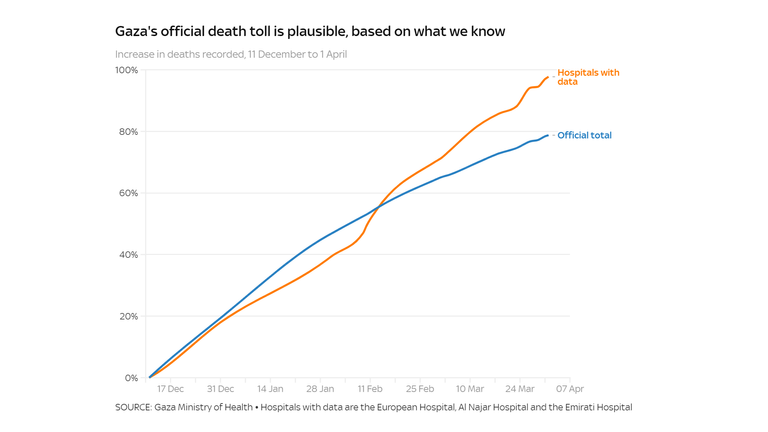
“It’s probably an undercount, if anything,” says Omar Shakir, Israel and Palestine director at Human Rights Watch.
“The numbers are consistent with what we know about the number of airstrikes and the types of weapons used and what we’re seeing on satellite imagery,” he says. “We would expect numbers in this range.”
Please use Chrome browser for a more accessible video player

0:56
Moment Israeli forces bomb tent at Gaza hospital
Palestinians are now able to report deaths online
Of the 21,703 identified fatalities,18,917 have come through hospital morgues.
The remaining 2,786 have been identified through a new system by which Palestinians can report deaths without a body – at a hospital, over the phone or through an online form.
Submissions require a full name and date of birth, as well as two adult witnesses. People are also asked to provide the national ID number of the deceased, to aid with identification.
This system was created in order to provide death certificates to the families of those buried without passing through a hospital, or whose remains are trapped under rubble.
“It is the right of all these martyrs and the wounded to have their names recorded,” says Dr al Qudra, the health ministry spokesman. “This is the simplest of their rights.”
Please use Chrome browser for a more accessible video player
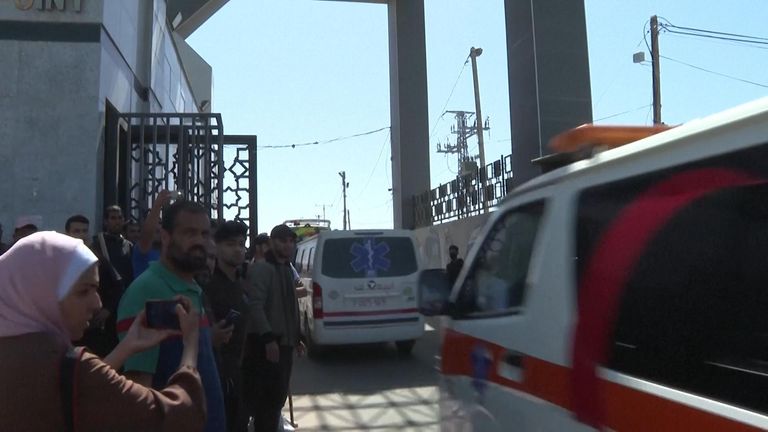
0:49
Killed aid workers transported to Egypt
The majority of deaths reported through this system (55%) are working-age men. Mr al Wahaidi says this is because it is mainly used by widows, who must formally register their husbands’ deaths to obtain government assistance.
Once a death is confirmed through this system, Mr al Wahaidi and his team add it to the hospital’s systems and one fatality is removed from the count of unidentified bodies.
Dr Bex Inglis, an Oxford-based doctor who trained medics in Gaza before the war, says her colleagues in the territory have told her about this system.
“When a lone person comes into the hospital and all their relatives are missing, the hospital will provide them a piece of paper to fill in the ID numbers of all of those who are missing.”
Even with multiple systems in place, the true number of people killed may not be known for some time.
“What I couldn’t understand is what happens when the entire family is killed, which is super common,” says Dr Inglis. “How do they get reported? And I was told that usually they don’t.”
The Data and Forensics team is a multi-skilled unit dedicated to providing transparent journalism from Sky News. We gather, analyse and visualise data to tell data-driven stories. We combine traditional reporting skills with advanced analysis of satellite images, social media and other open source information. Through multimedia storytelling we aim to better explain the world while also showing how our journalism is done.


